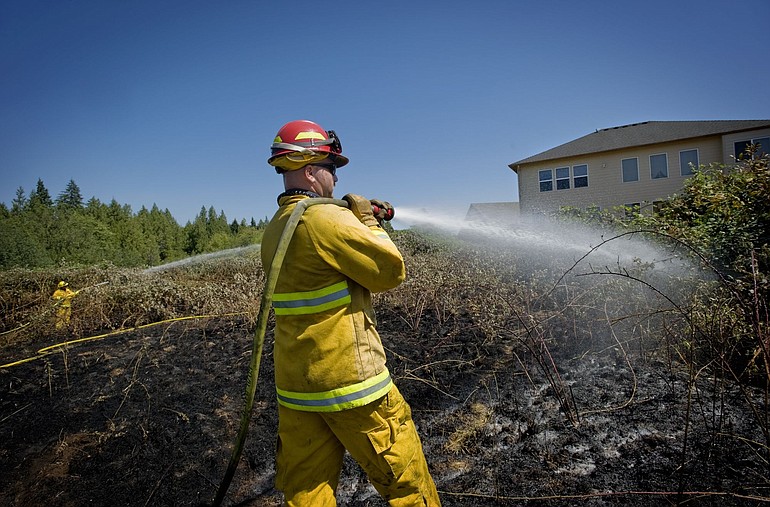HOCKINSON — Wildland firefighters, enduring scorching heat, on Monday began to make significant headway against a fire burning in industrial timberland in the Cascade foothills of east Clark County.
Yet, even as firefighters began to wrap a line around the remote Hilltop fire, firefighters from Vancouver to Camas scrambled to suppress grass fires in urban areas of Southwest Washington. Four days of 90-degree heat have rapidly dried out fuels such as high grass and brush — which grew prodigiously during an unusually wet spring and early summer.
“Fire doesn’t just happen on Larch Mountain,” Vancouver firefighter Jim Flaherty said.
One blaze erupted from foot-high grass in a greenway near Lacamas Creek, briefly threatening several homes in an unincorporated area of east Vancouver.
As Vancouver firefighters continued pouring water on the blackened earth and blackberry vines, Flaherty pointed out that it wouldn’t have taken much for the fire to hopscotch between the tightly packed homes along Northeast 38th Way.
A steady westerly wind pushed the fire into brush backing up against several wooden backyard fences, just as firefighters arrived to knock it down.
Flaherty said the situation reminded him of the notorious fire-prone landscapes around many cities in California.
In a worst-case scenario, he said, firefighters may have to make tough choices between houses they can defend and those they can’t.
“We might just have to say, ‘Those three homes are gone,'” Flaherty said. “That’s not a reality for folks around here, but it’s in our playbook.”
Hockinson-area residents, who have lived with that reality for several years, got another reminder over the weekend with the flare-up of the Hilltop fire near Larch Mountain.
Since it started shortly after noon on Saturday, the blaze has chewed through more than 60 acres of industrial timberland near the Yacolt Burn State Forest.
“It has people’s attention,” said Fire District 3 Deputy Chief Scott Sorenson, whose department fielded 30 calls an hour from concerned residents on Saturday afternoon.
Even though the fire was burning more than 2 1/2 miles away from the closest home, gusty east winds on Saturday created an outsized impression for hundreds of homeowners in the Cascade foothills. Residents of the tony Summer Hills subdivision, with views 20 miles away to downtown Portland, endured choking smoke rolling across the landscape from the fire burning 10 miles away to the east.
By late Monday afternoon, firefighters reported that the Hilltop fire was 46 percent contained.
The fire has racked up $228,000 in costs, with the money drawn from a wildfire fund administered by the state Department of Natural Resources. The fund is a type of insurance pool generated by an assessment against timberland owners, said Steve Hartsell, a DNR forester who is serving as a spokesman for the incident command team headquartered at Hockinson High School.
The team has employed two helicopters, one air tanker, numerous fire engines and tenders, and 150 people.
For the past several years, the local fire district has made a point of reaching out to homeowners associations and residents to spread the word about the hazard. Since the Yacolt Burn of 1902, thousands of homes have popped up within the footprint of a fire that covered 239,000 acres and killed 38 people.
This time of year, the danger rises as hot desert air from Eastern Washington pours through the Columbia River Gorge into brush-filled westside forests.
Ray Steiger, public information officer for Fire District 3, said firefighters operate on a kind of triage system during a wildfire. Homes surrounded by plenty of open space stand a better chance than houses crowded by trees, brush and narrow access.
“If we have a situation where a fire is approaching, and we may have evacuated people, we’re going to evaluate the defensible space,” Steiger said. “Can we stand a chance of putting a crew in there with two to three people and a hose line? Can we save that house?”
Hartsell, with the Hilltop incident command team, agreed.
“I think people have the idea that they’re going to have a fire truck parked in every driveway,” Hartsell said. “And that’s not going to happen.”
Erik Robinson: 360-735-4551, or erik.robinson@columbian.com.



